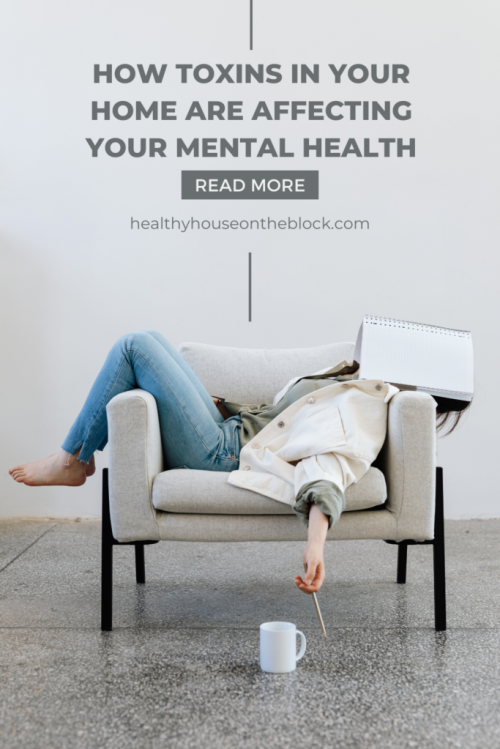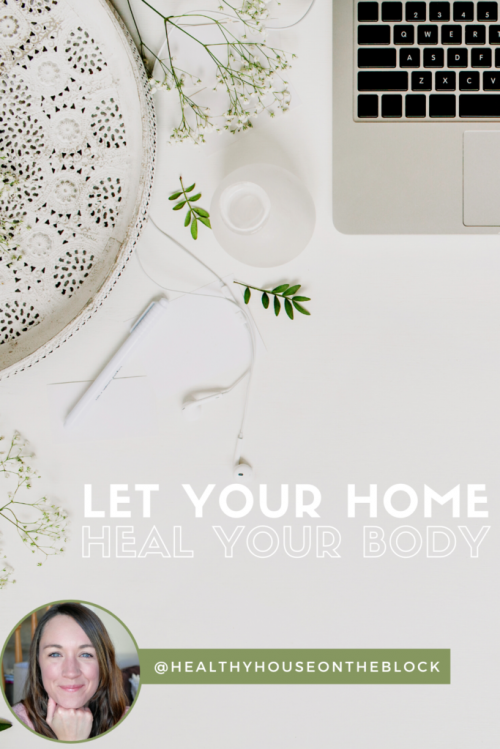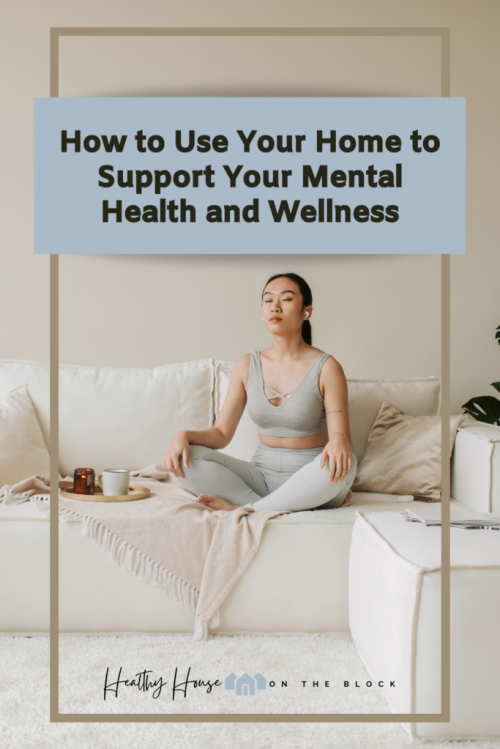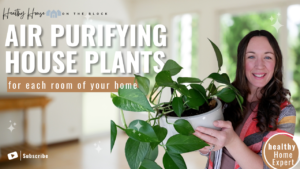
A healthy home is not just a house with fewer toxins, but it’s a space to feel safe inside. It’s a refuge from the exterior world and a place that you can invite others into. A home is a place where we often feel pride and comfort. And ultimately, we want a home that supports our physical health and our mental health. A true healthy home is one that encourages wellness, instead of burdening it down.
But while we’re taught how to eat healthy and reminded to keep moving our body and to get enough sleep — which are all healthy habits — many of us haven’t been taught the basics of a truly healthy home. When you purchase a home, no one walks you through how to reduce toxins inside or how to make your house into a healthy home.
These things come only if we seek out information and help. It’s not necessarily common knowledge that many home toxins are harming our health. Instead, many homeowners start uncovering this information AFTER there’s been a serious illness in their family or home. Many of us aren’t looking to create a healthy home for prevention, but more to heal an issue that has already arisen.
And the health issues that show up range from cancer to allergies that families want to heal from. One of the bigger and not as well known problems that we’ve seen come out of an unhealthy house are negative effects on mental health and wellness in addition to physical health.
Whether you want to heal or you want to prevent illness, today’s post will help you understand the toxins in your home and their connection to mental health and wellness.
IF TOXINS ARE A TRIGGER FOR YOUR ANXIETY:
I felt like I really needed to add this before jumping in. If learning about home toxins is overwhelming or causes anxiety for you, this may not be the post you want to read through. I never want to share information that causes a downward spiral, but I do want to share information in hopes that we can understand our homes more.
If you do feel compelled to read on, remember that NO ONE has a 100% toxin free home. There’s just no way to do it and live within a modern society. That being said, we can all make small changes to support our own physical health and mental health.
These small changes are what I 100% support and teach. Focus on the things you have control over. The things that are easy to change are where you should start. If you ARE ready to jump in and work through a step by step plan to create a healthy home, you can sign up for my Healthy Home Blueprint Course here, which will open soon.
Otherwise, I encourage you to go on this healthy house journey without panic or fear — they’re just as toxic to your body as some of the toxins you’ll be removing.

SPECIFIC TOXINS CONTRIBUTING TO MENTAL HEALTH ISSUES:
What has been found most recently is that there are some big toxins in our homes that are not only affecting our physical bodies, but also affecting our mental health. The list below are the toxins that have been shown to alter the brain in ways that set depression and other mental health issues in motion. They’re a catalyst for these problems. (STUDY)
It’s also important to remember that some of these toxins are prevalent not only in our homes, but in the products we buy for ourselves and our homes as well as the food we eat. Toxin removal must be approached from all three angles to truly eliminate dangerous exposures.
Pesticides: Pesticides have been found in our food, in our house dust and on our shoes — it’s a toxin that’s beginning to get a lot of press because we’re being exposed constantly. Studies have shown an association between pesticide exposure and depressive symptoms that can last well beyond the exposure to pesticides itself. The study also shows long term effects on mood, even when pesticides have been removed from the environment. (STUDY) (STUDY)
Heavy Metals: Metals such as lead, mercury and arsenic can potentially be in home materials. Generally these are in older homes,but we’re finding more and more new products that contain trace amounts of these metals or cadmium (as a dying agent). Heavy metals have been linked to anxiety as well as depression. The heavy metals quickly build up in the bloodstream and can cause a disruption of the brain chemistry, leading to these mental health issues as well as significantly weaken the immune system (STUDY).
Aluminum is another heavy metal that negatively affects mental health and can cause increased anxiety, depression, agitation, mood changes and personality changes over time. Aluminum is more a heavy metal that is in our home products like our pots and pans, cosmetics, kitchen products, but should still be avoided. (INFORMATION)

Solvents: Often something you bring into your home in the form of cleaners, paints, stains, waxes and polishes, solvents have health complications from not only high-dose exposure, but also low-level chronic exposure too. Solvents have been linked to depression, anxiety, psychosis, sleep disturbances and irritability even with low level exposure. (INFORMATION)
Toxic Gasses: Carbon Monoxide, which is from any gas appliances in your home (stove, furnace, dryer, water heater, fireplace, etc.), can build up in your home if appliances aren’t vented correctly. It can also come from a pilot light that stays lit even when the appliance is not in use. Carbon monoxide is not only deadly, but even in low, constant exposures, it has been shown to cause paranoia, mood changes, irritability, depression and anxiety. (INFORMATION)
Vinyl Chloride: Vinyl Chloride is the base for PVC products and plastics. It can be found ALL over our homes in plumbing pipes, flooring, windows, toys, shower curtains and some textiles. Most of us are exposed at low levels of PVC toxins when in our homes. Children appear to be affected at a much greater level to PVC exposure than adults. Studies show that even low grade chronic exposure to polyvinyl chloride has been linked to nervousness, depression, and insomnia. (INFORMATION)

WAYS TOXINS POISON THE BRAIN
The toxins that I mentioned above are toxins that end up impairing the brain in some way or disrupting a system in the body that affects the normal state of the brain. (SOURCE) (SOURCE)
Reduce Cerebral Flow: When blood flow to the brain is reduced, it has been associated with depression, bipolar disorder and ADD/ADHD. It is also the number one predictor that a person will develop Alzheimer’s in the future.
Disrupt Endocrine System: When the endocrine system is disrupted, it means the body is not producing the correct amount of hormones that is needed given the individuals needs. Once the hormone production is interfered with it can cause serious imbalances in the body, which can increase the risk of panic attacks, anxiety and depression.
Impair the Immune System: When the immune system is out of whack, it increases the risk of developing an autoimmune disorder as well as leaves the body susceptible to illness overall. Anxiety and depression are also two mental health issues that have been linked to an impaired immune system.

Disrupt the Gut Microbiome: The gut is a place that dictates SO many of our other systems and their health. Disruption of the gut and microbiome can result in leaky gut, which has also been known to coincide with ADD/ADHD and anxiety disorders.
Damage DNA: Toxins have the potential to damage the DNA in our bodies, which will accelerate the aging of the brain. Once this acceleration of aging occurs in the brain, it can lead to irritability, temper and irrational behavior, anxiety as well as memory loss.
SO WHAT DO YOU DO?
While all of this can feel very heavy and it’s some troubling information, there is actually a lot you can do at home to limit the exposure of toxins in your healthy home and safe space.
Do your best: Avoid toxins wherever you can: cleaning products, beauty products, food, etc. Be sure you know what’s coming into your house and then don’t stress about things you’re unable to change. If you think that someday you may be able to change out flooring or another toxic area of your home, go for it! If you can’t, just focus on what you can have some control over.
Remember no home is free from toxins: Give yourself some grace and remember that NO ONE has a toxin free home. There is not one space that is completely free from toxins. Being aware of toxins in your home is half the battle, and chances are if you’re aware of the toxins, you are doing a great job of reducing them wherever you can.
Air out whenever possible: One of the best ways to reduce the toxins in your healthy home is by improving the air exchanges. This can be done through simply opening up windows and letting fresh air inside. You can also take advantage of mechanical ventilation to get air circulating and sent outside. It’s your biggest tool as a homeowner and many of us forget to use it. My free workbook download: Toxin Free Home is full of practical and low cost ideas to help you get fresh air into your home and reduce toxins inside.
Test for heavy metals: If you’re really concerned about your home’s space and your health because of potential heavy metals, it doesn’t hurt to have yourself or your home tested. Oftentimes doctors and especially pediatricians can do simple blood tests that check for heavy metals like lead, mercury and other highly toxic metals. You can also have a test done inside your home to determine if metals are in your water or inside your home. I think it’s best to start with a simple blood test as it’s often not very expensive. If it’s positive for heavy metals, you can move on to check your home if that’s a concern.
Commit to avoid solvents and chemicals: Whenever you can avoid harsh chemicals or solvents (in paints, wood stain and glue, etc.), by all means do it. It’s a simple way to avoid so many toxins in your home and all it takes is a little bit of research and knowledge before you buy our products. You can learn more about toxins in chemicals and building materials in my Toxin Free Building Materials List.

Toxins in our homes are unfortunately creating health issues that range from physical to mental health problems. The good news is by creating a healthy home space, you can actively reduce the risk of these issues and instead support your body’s health and wellness.





Pingback: Using Your Home to Benefit Your Healthy Living »